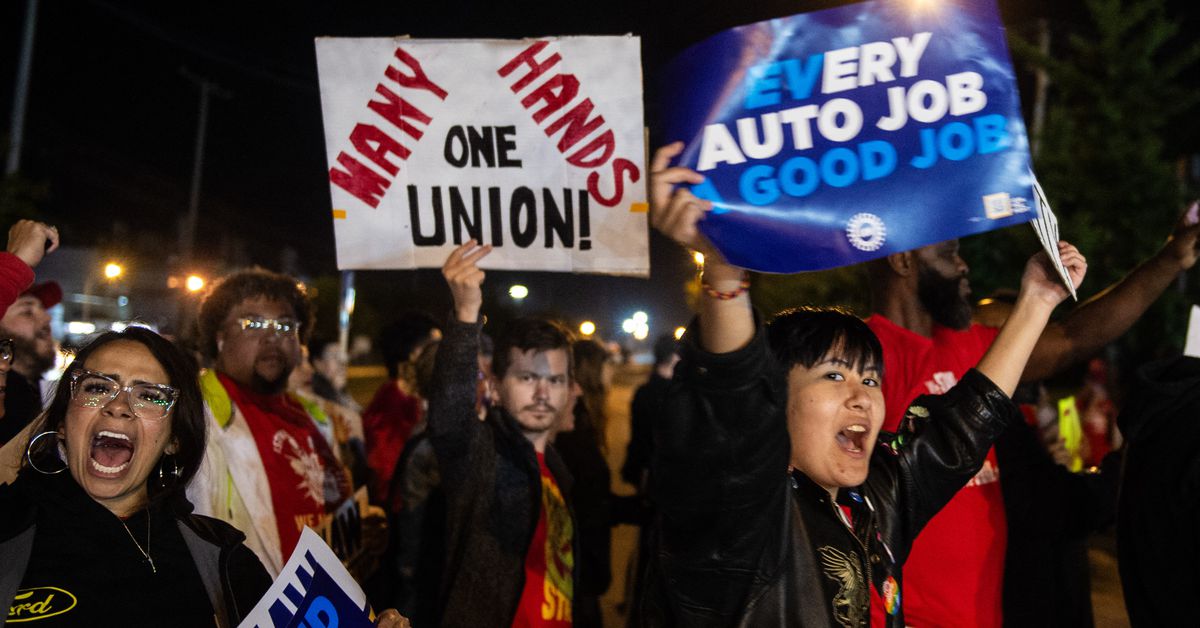The UAW strikes autoworker contract ev-ford gm-stellantis: “The revolution is on hold as the ‘Big Three’ autoworkers go on strike”
“People are angry,” Brandon Szcesniak, a 21-year-old union member who works at Ford’s Wayne plant, told Labor Notes. It is similar to a revolving door. It isn’t a career anymore, it is a job. They want us to buy Fords, but how can we buy a Ford on this pay?”
The UAW has struggled to find a foothold at the factory which is run with nonunion labor. The company has also been accused of violating labor law by the National Labor Relations Board for barring workers from discussing pay and working conditions. There have been many complaints against the company over the years.
Dan Ives said it’s a nightmare situation for GM and Ford as both of them are in the early stages of a massive EV transformation path for the next decade. He added that the “clear winner was… The champagne is on ice.
Trade-Offs Between Automobile, Mid-Atlantic, and High-Stakes Automakers: The UAW Trade Agreement Is Still Going Strong
Sam Fiorani of AutoForecast Solutions reckons that this is a symbolic strike and not a real damaging one. Not everyone was in agreement.
This is the first time in the history of the US auto industry that workers are striking at the same time. Auto building depends on long-term contracts, and in a prolonged strike suppliers would only be able to lean on whatever business they already have with foreign automakers or nonunionized manufacturers, including Toyota, Honda, and Tesla.
The union claims that the three automakers have made $21 billion in profits in the first six months of the year, and workers want their fair share.
It was a historic moment — never before had workers at all three companies gone on strike at the same time — that came as the automakers were in the midst of making a huge high-stakes switch to EVs.
Those plans are on hold, as workers from Ford, General GM and Stellantis take to the streets to demand better retirement plans and better job security as well as a greater share of the profits generated by trucks and SUVs.
The UAW has bristled at the idea that its walkouts will hurt the US or its workers. The UAW president said earlier this week on Good Morning America that it was going to wreck the billionaire economy. The union has justified its demand for 36 percent raises for workers over the course of the contract in part by pointing out that executive pay has risen by even more over recent years. The billionaire class is in control of everything. The working class is being left living paycheck to paycheck and feeding off the scraps,” Fain said.
Ford said it got a counterproposal from the union hours before the current contract expired but said there was “little movement” from the UAW’s previous proposal.
Ford said that the proposal would double its current UAW related labor costs which are already significantly higher than the labor costs of other foreign-owned automotive companies in the United States.
The Covid-19 Autodemic: GM, Ford, the Wall, the Drive, or What Has the World To Tell Us? An Automotive Analyst’s Perspective
The two sides were still far apart on a number of issues. “We still have a ways to go with the offer they put on the table last night,” Barra said on CBS This Morning on Friday.
While the Big Three spend about $65 an hour on total labor costs, their non-union rivals only spend about $55 an hour and the company spends less than $50 an hour.
“The big issue for GM and Ford as well as investors is around if anywhere near a ~40% wage increase gets approved/agreed this will be a major headwind on the cost front and ultimately in some way be passed down to the consumer and thru EV prices,” he wrote in a research note. The advantage of having EV vehicles in Detroit goes after mass adoption with any $3k to $7k added to the cars coming out would result in demand Churning in our opinion.
The strike could push the Big Three to agree to increases in labor costs, which could then be passed along to the consumer.
Mike Wall, an automotive analyst with the research firm S&P Global Mobility, said suppliers have been through a lot over the last three and a half years. There was the pandemic, sure, but also a related microchip shortage that bit hard because vehicles now require more computing components; a commodity squeeze influenced by war in Ukraine; inflation; and interest rate hikes.
If automakers fail to reach an agreement with the UAW, a nasty domino run will begin inside the auto supply chain over the next few weeks and months. The giants of Detroit will tell their largest suppliers to stop sending them new parts, and these companies will in turn tell their own suppliers to stop sending them components. The suppliers could stop sending the stuff to the companies if they told them to, but they wouldn’t have access to the cash they would need to hold onto.
The public was made aware of the world’s network of manufacturers, assemblers and shippers behind just about every consumer goods that arrives on your doorstep thanks to the Covid-19 Pandemic. Or a driveway. Car prices soared as automakers struggled with a supply chain jammed up by worker shortages, chip shortages, and shipping delays.
